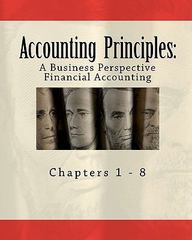Question
1) What was the main reason cited in the article for the fact that people were buying more toilet paper last Spring? 2) How does
1) What was the main reason cited in the article for the fact that people were buying more toilet paper last Spring?
2) How does annual per capita consumption of toilet paper in the U.S. compare with other countries?
3) In what ways have toilet paper companies adjusted to meet the demand of household consumers?
4) Do you think it was ethical for restaurants and cafes to offer takeaway toilet papers at such prices? Explain briefly.
5) Since market prices for toilet paper soared, would it have been helpful for the government to issue price controls? If so, what kind, and would there be any unintended (or bum-intended) consequences of such a move?
ARTICLE:
In an effort to keep trading during the coronavirus pandemic, Old Ebbitt Grill, one of Washington DC's oldestrestaurants, began serving takeaways. Its menu, which usually offers oysters and steaks to tourists lunching across from the White House, now features a new item:toiletpaper, costing $2.50 a roll and limited to two per order.
As the Covid-19 panic-buying empties supermarket shelves oftoiletpaper, manyrestaurants, hotels and offices devoid of their usual visitors are flushwithit.
Leon, arestaurantchain that usually focuses on selling flat whites and halloumi wraps to passing office workers, says it started offeringtoiletrollswithonline orders when it realised customers were struggling to find them in supermarkets.
"Meanwhile,withrestaurants, bars and hotels closed, the hospitality supply chain has been sitting on an abundance of [toiletroll] stock," says Glenn Edwards, managing director of Leon's US division.
Nielsen, which measures supermarket data, reported a 71 per cent year-on-year increase in US retailtoiletpapersalesin the nine weeks to May 2. Although some of this increase can be attributed to reports of widespread hoarding as the coronavirus pandemic took hold, analysts say much of the demand for supermarkettoiletroll is down to the fact that consumers are spending more time at home.
Georgia-Pacific, a US maker oftoiletpaperfor both commercial and retailsale, estimates that working from home increases householdtoiletroll usage 40 per cent.
According to data provider Statista, UStoiletpaperconsumption is the world's highest,withAmericans buying more than 7bn rolls each year, equating to 141 rolls per person. This outstrips the 134 rolls used annually per person in Germany, 127 in the UK, 88 in Australia, 71 in France and 49 in China.
Georgia-Pacific says that while recent demand from hotels andrestaurantshas decreased, it is preparing for a rebound as cities across the US begin to reopen.
Procter & Gamble, the household products conglomerate, is one of the three biggest producers oftoiletpaperin the US. Its Charmin brand oftoiletroll is one of many household items that has seen higher demand during the coronavirus pandemic, as people spend more time at home.
"As the pandemic unfortunately developed in the US and Europe as the quarter progressed, demand surged," Jon Moeller, chief operating officer and chief financial officer, said last month when P&G reported its biggest quarterly profit for decades. The company said it had boostedtoiletpaperproduction in an effort to meet heightened demand.
"[Household] products are more important than ever given the needs presented by the current crisis, the increased awareness around health and hygiene, and the additional time many of us are spending at home," Mr Moeller added.
Rick McLeod, P&G's family care product supply vice-pres-ident, says demand for Charmin is at "record levels".
"We're seeing very clearly that consumers view our products as essential," says Mr McLeod. "People are going to be using our products at home, rather than at hotels orrestaurants."
By narrowing production to its most popular brands and packet sizes which minimises factory line stoppages P&G has boosted itstoiletpaperoutput to copewithheightened demand.
Georgia-Pacific also increasedtoiletpaperoutput, producing 1.5m extra rolls a day. The company is bypassing distribution hubs by shippingtoiletpaperdirectly to supermarkets, which Georgia-Pacific says has cut its delivery times "by up to three days".
The American Forest andPaperAssociation says 700,000 tonnes of tissue andtoiletpaperwas produced by USpapermills in March, the highest monthly total since the association started collecting data in 2007.
Toiletpapermanufacturers say that rolls made for commercial venues sometimes differ frompapersold through supermarkets for home use, meaning that consumers may have to adapt to a different product.
While commercialtoiletroll is sometimes produced in larger sizes often for use in dispensers paperfor home use is more likely to be made of softer, higher grade tissue, and may be decorated, scented or "contain emollients and lotions for added comfort and desirability", according to the American Forest andPaperAssociation.
But despite the increased production, there remain many empty supermarket shelves across the US,withrestaurantsand cafs increasingly seeing a valuable side income in selling their sparetoiletroll via delivery apps.
In Washington, one popular delivery app lists 52restaurantsoffering takeawaytoiletpaper. As well astoiletroll, Old Ebbitt Grill and several of its rivalrestaurantsalso sell reusable homemade face masks and hand sanitiser.
"It continues to be a nightmare for people to buytoiletpaper," maintains Leon's Mr Edwards.
The hospitality supply chain has been sitting on an abundance of stock
CREDIT: Aime Williams
CAPTION: On a roll: Leon, arestaurantchain, now sellstoiletpaperBloomberg
Word count:804
Copyright The Financial Times Limited May 28, 2020
Step by Step Solution
There are 3 Steps involved in it
Step: 1

Get Instant Access to Expert-Tailored Solutions
See step-by-step solutions with expert insights and AI powered tools for academic success
Step: 2

Step: 3

Ace Your Homework with AI
Get the answers you need in no time with our AI-driven, step-by-step assistance
Get Started


